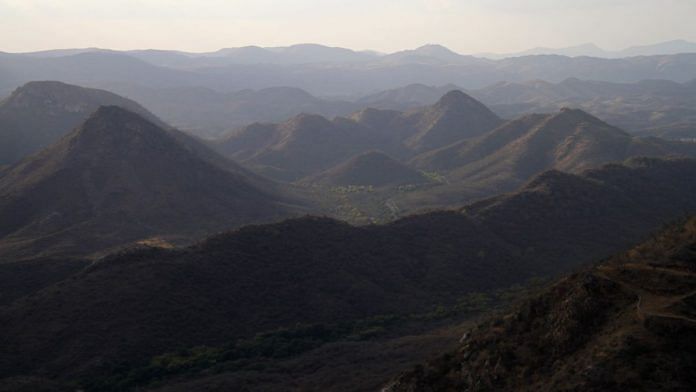Thank you dear subscribers, we are overwhelmed with your response.
Your Turn is a unique selection from ThePrint featuring points of view from its subscribers. If you are a subscriber, have a point of view, please send it to us. If not, do subscribe here: https://theprint.in/subscribe/
Fascinating Aravallies:
Aravalli mountain range is fascinating. It has varied hues from blackish to reddish to whitish. It has varied climates from consistently hot – wet to hot-dry to dry- windy to cool to localised short-duration flash flood rains. It has tribes like Bhil, Bhil-Meena, Meena, Grasia, Damor and Kathodia. It has centuries-old temples like Ranakpur Jain temple & Dilwara temples. It also has Tara Garh Fort the oldest fort in Rajasthan.
The Aravallies have played a significant role in shaping the geography, culture, and lifestyle of the people living in the region.
It has been site of three broad stages of human history, home to three major rivers, innumerable life forms and a treasure trove of zinc, lead, copper and other metals along with marble and stones. And foremost it is the oldest mountain range on earth. The mountain range is characterised by rugged hills, rocky outcrops, and sparse vegetation, and has played a crucial role in the region’s ecology and hydrology.
Aravallies slap back :
Mining of copper and other metals in the Aravalli dates back to 5th century before current era. However, it was a respected and revered mountain range.
Only very recently its forests became most degraded, its oxygen-giving carbon dioxide absorbing capacity reduced, its biodiversity dwindled and its water retaining capacity dipped down. Man raped Aravallies. Powerful Aravallies have slapped back. Climate in north India has been affected. Wildlife has moved to human habitation areas. Water cycle has altered leading to acute water scarcity on one side and flash floods on the other.
Understanding Aravallies
Spread over an area of 725 km in four states with Rajasthan having 80% and Delhi and Haryana and Gujrat the other 20%. In Gujrat it has Greyish black sedimentary rocks, in Rajasthan sand and rose-coloured quartzite stones and in Rajasthan and in Delhi & Haryana whitish to greyish sedimentary rocks.
Aravallies are being raped by all four states. In Gujrat by hotel construction; in Rajasthan by mining and encroachments ; in Haryana by mining and conversion of land use and in Delhi by explosive urbanization.
In the olden times Aravallies was a continuous stretch in Delhi but at present it exists in four pockets- as Asola Bhatti sanctuary in south, Sanjay Van in south central, Nanak Sar Gurudwara in central and Kamala Nehru Ridge in north Delhi.
Haryana tops the chart in the country for diversion of forest land of Aravallies for non-forest use. For a very long time the landlords mined Aravallies at the border of Delhi and Haryana with impunity. Their trucks loaded with mined treasures passed through Asola Bhatti sanctuary. One time a landlord blasted a part of Aravallies to make a helipad so the bride and groom could fly away from the venue after marriage.
When one looks down from an aircraft while landing in Delhi one can see how Aravallies around Delhi have either flattened or manicured as landscaping feature for farm houses and even schools.
Aravalli Range in Rajasthan is still a continuous stretch, a natural barrier between the Thar desert and the fertile plains, most important water shed, climate regulator and biodiversity hub preventing the desert from spreading eastward.
However, recently it has experienced exploitation by outsiders and a few corrupt insiders. One time I was travelling from Alwar to Delhi on small narrow roads. I came across Anil Agarwal Environment Training Institute. All around that eco-friendly building complex Aravallies were being razed to ground with impunity.
Gujrat has been smarter in looking after its small stretch of Aravallies. It has the greenest forest cover.
Of the 38 national parks, wildlife sanctuaries, and reserve forests on Aravallies 16 are in Haryana, 10 in Rajasthan, 9 in Delhi and only 3 in Gujrat. This number is of no importance because in spite of the lowest number Aravallies in Gujrat are the greenest and in spite of the highest number Aravallies of Haryana are most exploited. There is an inverse relation between decreased forest cover on Aravallies and increased mining area.
Every now and then schemes, plans , programs are announced for safe guarding Aravallies. During the last 50 years mining has been banned for over a dozen times but as most work is on paper mining goes on and forests of Aravallies keep degrading
Last words
One fails to understand the convoluted human mind. It first cuts the trees to make money, blasts the earth below to sell its bounty and make money, plants trees in lakhs on paper and make money.
Let me share a message I recently got from a cousin. We cut trees to make paper and write on paper ‘do not cut trees’.
These pieces are being published as they have been received – they have not been edited/fact-checked by ThePrint


